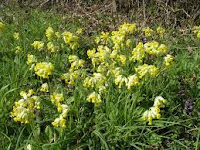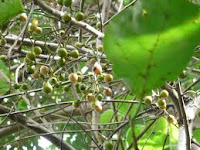For centuries people have been commenting on the oxlip’s similarity to cowslips (Primula veris) and they have been described as cowslip stems with primrose flowers. They are members of the Primulaceae family of plants and so are related to moneywort or creeping Jenny and the scarlet pimpernel (Anagallis arvensis), all of which are native to Europe , including the British Isles . However oxlips are now mainly found in eastern counties, and are rare further south than Hertfordshire.
Oxlips are used in the same ways as cowslips in traditional herbal medicine, and in 2008, 23rd September the European Medicines Agency published an assessment report on the tow and concluded that preparations containing the flowers could be regarded as safe as they have been used for more than thirty years without reports of deaths or adverse side effects other than allergies. They have been used for coughs and catarrh and bronchitis as well as for their diuretic properties and so were useful for gout and rheumatism. They have also been used for headaches and migraines and in fevers to promote sweat.
The root extracts containing saponins have been found to have antibacterial and fungicidal effects too.
The young leaves may be eaten raw or cooked as a vegetable, like spinach, or added to soups and stews. They have a mild flavour and can be found in woodlands in late winter and early spring.
Oxlips can mainly be found in ancient woodlands which have oak, ash, field maple and hazel as dominant tree species. Oxlips have a preference for shady places and are sometimes confused with the false oxlip (Primula x polyantha), but these have shorter stems and a deeper yellow or golden flower.
Nicholas Culpeper the English herbalist writing in the 17th century had this to say about the oxlip, which he thought might have been a hybrid species: -
“Government and virtues. It is a plant of Venus, and is good against disorders of the nerves. The root has the principal virtue; the country people boil this in ale, and give it for giddinesses of the head, with success. The juice of the plant, mixed with veinegar, is also used to snuff up the nose against head-achs. It is less violent than the juice of the primrose root, and answers the same purpose very well.”























